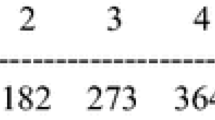Abstract
This is an expository article showing how Zeck-endorf’s Theorem (every positive integer can be represented in one and only one way as the sum of non-consecutive Fibonacci numbers) can be used to construct a number-guessing game invented by Professor George Andrews.
Similar content being viewed by others
Suggested Reading
Parmanand Singh, The So-called Fibnonacci Numbers in Ancient and Medieval India, Historia Mathematica, Vol.12, pp.229–244, 1985.
Ronald L Graham, Donald E Knuth, and Oren Patashnik, Concrete Mathematics, Addison-Wesley Publishing Company, Reading, Massachusetts, October 1990.
E Zeckendorf, Représentation des nombres naturels par une somme de nombres de Fibonacci ou de nombres de Lucas, Bulletin de la Société Royale des Sciences de Liége, Vol.41, pp.179–182, 1972.
Author information
Authors and Affiliations
Corresponding author
Additional information
Jerold Mathews is professor (emeritus) of mathematics at Iowa State University, Ames, Iowa, USA, where he served on the faculty from 1961–1995. His interests include research in point set topology, history of mathematics and writing textbooks. He enjoys reading, photography and helping international students learn English.
Rights and permissions
About this article
Cite this article
Mathews, J. George Andrews’ game. Reson 14, 172–178 (2009). https://doi.org/10.1007/s12045-009-0015-7
Published:
Issue Date:
DOI: https://doi.org/10.1007/s12045-009-0015-7




